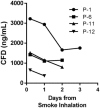Circulating cell-free DNA as a potential marker in smoke inhalation injury
- PMID: 30896631
- PMCID: PMC6708904
- DOI: 10.1097/MD.0000000000014863
Circulating cell-free DNA as a potential marker in smoke inhalation injury
Abstract
Failure in evaluation of smoke inhalation injury (SII) is related to increased morbidity and mortality. Prognostic biomarkers that reflect the injury are undoubtedly needed. Cell-free DNA (CFD) concentrations are associated to the extent of tissue damage and inflammation in various pathologies. We have developed a simple assay for CFD quantification and previously found it prognostic in various pathologies including burns, lung disease, and sepsis. The aim of this study was to evaluate admission CFD as an injury severity marker in patients with SII.In a prospective study, we measured admission CFD levels in 18 SII patients and matched control subjects. Daily CFD levels were also performed in 4 hospitalized patients. Serum CFD levels were measured by our direct rapid fluorometric assay.Admission CFD levels of SII patients were significantly higher than those of healthy controls, 879 (236-3220) ng/mL vs. 339 (150-570) ng/mL, [median (range)], P < .0001. Admission CFD levels of hospitalized patients were significantly higher than those of nonhospitalized patients, 1517 (655-3220) ng/mL vs. 675 (236-1581) ng/mL, P < .05. Admission CFD positively correlated with hospitalization time (Rho = 0.578, P < .05) and was in linear correlation with CO poisoning (carboxyhemoglobin (COHb) levels, R = 0.621, P < .0001). Additionally, along with the recovery of hospitalized patients, we observed a matched reduction of CFD levels.CFD appears to be a potentially valuable marker for severity and follow-up of SII. We believe this rapid assay can help introduce the routine use of CFD measurement into daily practice.
Conflict of interest statement
All authors declare that they have no conflicts of interest.
Figures



Similar articles
-
Circulating Cell-Free DNA Levels in Patients with Metastatic Renal Cell Carcinoma.Oncol Res Treat. 2017;40(11):707-710. doi: 10.1159/000479523. Epub 2017 Oct 23. Oncol Res Treat. 2017. PMID: 29065412
-
Severity of Inhalation Injury is Predictive of Alterations in Gas Exchange and Worsened Clinical Outcomes.J Burn Care Res. 2017 Nov/Dec;38(6):390-395. doi: 10.1097/BCR.0000000000000574. J Burn Care Res. 2017. PMID: 28570316
-
Expression profile of microRNAs in bronchoalveolar lavage fluid of rats as predictors for smoke inhalation injury.Burns. 2018 Dec;44(8):2042-2050. doi: 10.1016/j.burns.2018.07.009. Epub 2018 Aug 20. Burns. 2018. PMID: 30139538
-
Smoke inhalation: diagnosis and treatment.World J Surg. 1992 Jan-Feb;16(1):24-9. doi: 10.1007/BF02067110. World J Surg. 1992. PMID: 1290262 Review.
-
Ventilatory support following burns and smoke-inhalation injury.Respir Care Clin N Am. 1997 Mar;3(1):21-49. Respir Care Clin N Am. 1997. PMID: 9390901 Review.
Cited by
-
Circulating cell-free DNA in health and disease - the relationship to health behaviours, ageing phenotypes and metabolomics.Geroscience. 2023 Feb;45(1):85-103. doi: 10.1007/s11357-022-00590-8. Epub 2022 Jul 21. Geroscience. 2023. PMID: 35864375 Free PMC article.
-
Aerosol inhalation of edaravone can improve inflammation, oxidative stress and pulmonary function of rats with smoke inhalation injury by down-regulating miR-320.Am J Transl Res. 2021 Apr 15;13(4):2563-2570. eCollection 2021. Am J Transl Res. 2021. PMID: 34017415 Free PMC article.
-
Assessment of cancer biomarkers in the Grenfell firefighter cohort study.Sci Rep. 2025 May 7;15(1):15784. doi: 10.1038/s41598-025-95991-y. Sci Rep. 2025. PMID: 40335574 Free PMC article.
-
Cell-Free DNA: Potential Application in COVID-19 Diagnostics and Management.Viruses. 2022 Feb 4;14(2):321. doi: 10.3390/v14020321. Viruses. 2022. PMID: 35215914 Free PMC article. Review.
-
Day One Cell-Free DNA Levels as an Objective Prognostic Marker of Mortality in Major Burns Patients.Cells. 2025 Jun 1;14(11):821. doi: 10.3390/cells14110821. Cells. 2025. PMID: 40497997 Free PMC article.
References
-
- Fujioka M, Yakabe A. Does inhalation injury increase the mortality rate in burn patients? Investigation of relationship between inhalation injury and severity of burn surface. Signa Vitae 2009;4:20–2.
-
- Neuwalder JM, Sampson C, Breuing KH, et al. A review of computer-aided body surface area determination: SAGE II and EPRI's 3D Burn Vision. J Burn Care Rehabil 2002;23:55–9. discussion 54. - PubMed
-
- Kwon HP, Zanders TB, Regn DD, et al. Comparison of virtual bronchoscopy to fiber-optic bronchoscopy for assessment of inhalation injury severity. Burns 2014;40:1308–15. - PubMed
MeSH terms
Substances
LinkOut - more resources
Full Text Sources
Miscellaneous

